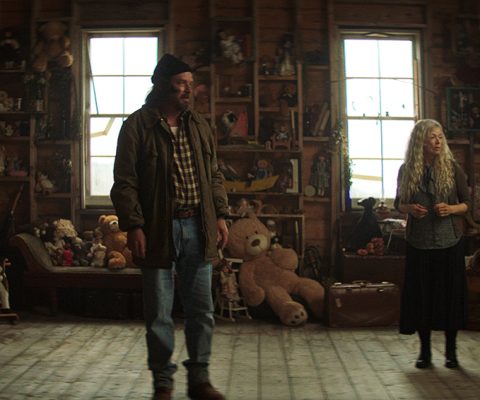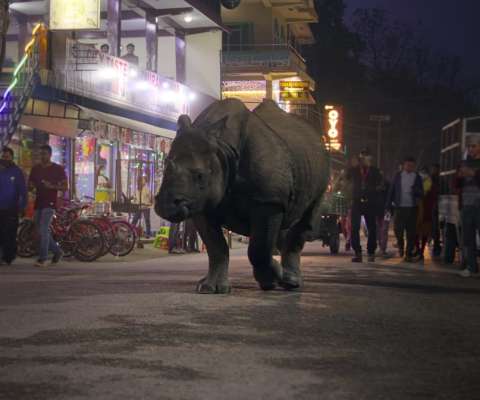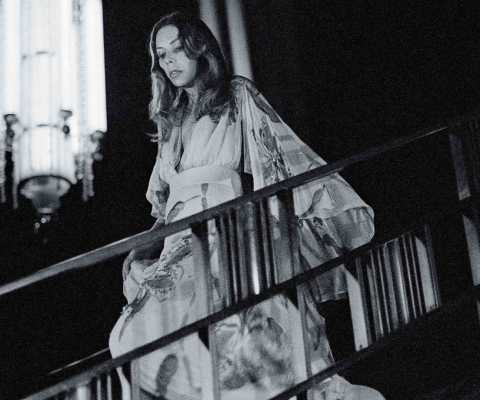“I basically said to myself because we have no one financing this film, let’s make the film that no one would finance.”
This is a good quote to read before hearing more about Joel Ashton McCarthy’s Shooting The Musical. The title is a double entendre, as it’s a mockumentary about some recent film grads filming a musical… which also happens to be about a high school shooting (called “High School Shooting: The Musical”). Of course this idea is balked at by many, but that’s the point. In the opening scene, the main character Adam (played by Bruce Novakowski) draws a penis on his passed out roommate’s face. He doesn’t realize at the time that his roommate is passed out because he just took a lethal amount of sleeping pills. Suicide in real life is not funny, but when you have a clueless character like Adam dealing with sensitive issues like school shootings, that’s a recipe for comedy.
Shooting The Musical had its Toronto premiere last night at the Canadian Film Festival. I spoke at length with McCarthy about the line this film walks between being offensive and being commentary, it’s connection to The Dirties, and why the cinematographer didn’t wear pants, among other things.
DS: The film premiered in Whistler as ‘After Film School’, why did you change the title?
JM: For a while we were kind of in denial about it, but every time you pitch someone on a movie called “After Film School”, they’re like ‘oh that’s cute, you’re making a little movie’, a lot of people really thought little of it. It sounded very amateur. We’d only done one festival at that point in time. It’s tough for us because we still call call it “After Film School” so it’s been a hard adaptation but we thought we should really just go out there with the fun aspect of the film. It’s a lot of things but at the end of the day when someone goes to see the film and they’re telling their friends about it, it’s about these guys making a high school shooting musical. I liked it being called “After Film School” because then the craziness just kind of creeps up on you, but we gotta get bums in seats.
DS: Do you think this movie could have gotten made in the States, where they’re more sensitive about this kind of thing?
JM: Going into this film, I basically said to myself because we have no one financing this film, let’s make the film that no one would finance. When we were shooting in Vancouver, so many people still thought it was in bad taste. I’m a big fan of South Park and I see how they push the envelope and as long as you have at least one character pointing out the antithesis you can kind of do whatever you want.
DS: So the assistant director character is your Stan and Kyle.
JM: Exactly. You also have the girl who quit the show as soon as she saw the script.
DS: What would you tell people who thought it was in bad taste?
JM: I think if you see the film you can tell it’s not really in poor taste. It’s a film about Canadian independent film. If you want to make an indie film, you gotta do something outrageous in order to get attention because there’s so much saturation of content and everyone’s a creator. We thought it was such a great, absurd idea because it’s something that’s attention grabbing. My philosophy is never apologize for fiction. The reason we have film is we get to see events unfold that didn’t happen.
DS: The Dirties is another Canadian indie film that explored similar territory a couple years ago. How would you describe this film’s relationship to that one?
JM: We were almost done shooting the film when Lana (Otoya, the producer) found the trailer and was like ‘oh shit’. I saw the trailer was like, okay, we’re already in this, I’m not going to watch this movie until we’re done the film. When I’m exporting the film, then I’ll sit down and watch The Dirties. I was very happy to see that we dealt with it in two very different ways, it’s a completely different film. I’m glad that ours had the musical element, because that really separates it.
DS: In the film you have Casey Margolis, who as a child played young Seth in Superbad, playing a douchebag version of himself. How did that come about?
JM: Every year I go to the National Film Festival for Talented Youth. I had a film there one year, and Casey had a film there as well. He just really connected with our film and wanted to meet me and ask questions about filmmaking. I kind of became a bit of a script mentor to him. It was really random when I found out that he was the kid in Superbad. Someone posted the clip years after, and I went ‘oh my gosh, I think that’s Casey’ and looked it up and found out the kid I’d been mentoring was the dick kid from Superbad. I really love the idea of having a really lame celebrity cameo in their film. I find especially with Canadian films, they work their asses to off to get like, Pamela Anderson for five hours and then make the entire trailer Pamela Anderson. I thought it be really funny to get the worst cameo would could think of, and Casey was dying to be a part of our movie.
DS: I imagine the film mirrored actual experiences you went through while making it, particularly when it came to securing locations.
JM: Yeah, we had the cops come to our set three times and shut us down because we didn’t have location permits. We tried to get a high school to shoot in, no high school wanted us so we ended up writing a fake script called “First Block” with all the locations we needed. We riffed about it and I got my roommate to write up a draft really fast. He sends it to me and I start script editing it, then all of a sudden I’m like ‘what the fuck am I doing? We’re not going to shoot this movie.’ Just save, done.
DS: And if any of them come back wanting to see ‘First Block’?
JM: That’s when you go “I’m sorry”. It’s easier to ask for forgiveness than permission. That’s our unfortunate motto. No one’s going to give us that first chance to make something unless we can show that we’ve made it already, we’ve done something. So hopefully for the next one we don’t have to do sleazy deals. Really hoping for that.
DS: What was the craziest locations bust?
JM: When we were doing a scene where we had cops in our movie chasing Rory (Tucker) in his underwear through an elementary school parking lot and then the real cops pulled up. We really stealthily got in the car but we couldn’t fit everyone, I was like get the guy in the underwear in the car and we left the two fake cops there. Then we were like, wait a minute, isn’t impersonating an officer worse?
DS: Did I miss something, or was there ever an explanation as to why the cinematographer in the film didn’t wear pants?
JM: We had a line and we ended up cutting because it made the scene really long, but basically it’s a comfort thing and then we just didn’t end up explaining it. We were like you know what audience, deal with this, it’s just how this guy is. Rory just has such a free spirited way about him that you buy that he’s the kind of guy who would just be in his underwear.
DS: Who did the original music for the film?
JM: This extremely talented duo Stewart Yu and Lina Debrosin. In Vancouver they’re really big in the musical theatre scene. I knew Stewart’s work, he did a musical about Archie comics and the music was so catchy. Everything was stuck in my head and I was like I need to get this guy. I wrote really bad versions of all the songs. They worked fast and made them so damn good. That end song I can’t take much credit for. I needed all these themes wrapped up, it should be about the high school shooter but also what’s going on in Adam’s life. It was really tough and he definitely is the unsung hero of the film.
DS: What’s on your Dork Shelf?
JM: I collect the worst inspirational wall art, like wall stickers and stuff like that. Anything that’s like ‘Hope. Faith. Love’, ‘Every Day Is A Gift’ and ‘God Bless This Home’. Anything that I think a 70 year old woman would want in her house, I love that stuff.







Comments